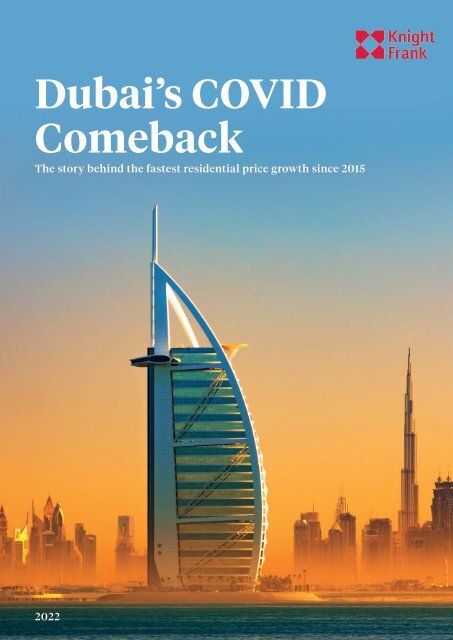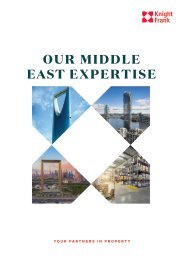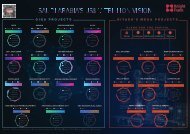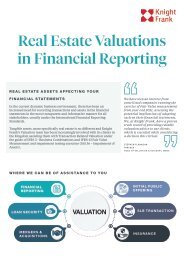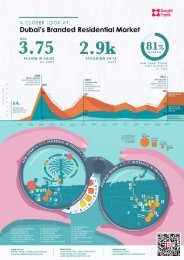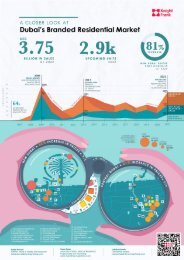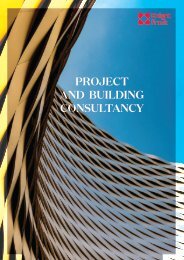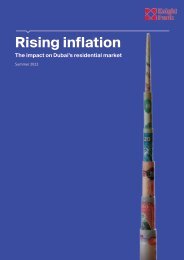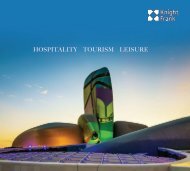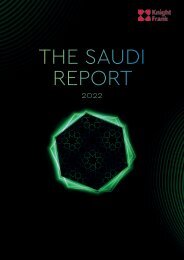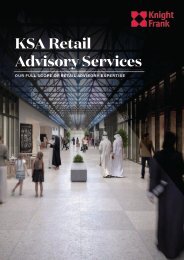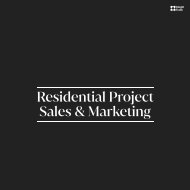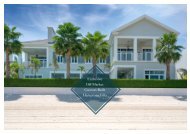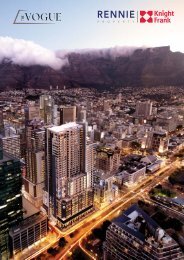Dubai's Covid Comeback
The story behind the fastest residential price growth since 2015.
The story behind the fastest residential price growth since 2015.
- TAGS
- real estate
- covid
- dubai
- residential
Create successful ePaper yourself
Turn your PDF publications into a flip-book with our unique Google optimized e-Paper software.
Dubai’s COVID<br />
<strong>Comeback</strong><br />
The story behind the fastest residential price growth since 2015<br />
2022
DUBAI’S COVID COMEBACK<br />
DUBAI’S COVID COMEBACK<br />
FOREWORD<br />
Following the spectacular Prime residential price growth in 2021,<br />
Dubai’s property market looks set to experience a more “normal”<br />
year in 2022.<br />
When the pandemic brought the world economy and property markets to a grinding halt<br />
in early 2020, little did we know that the onset of COVID-19 would be the turning point in<br />
Dubai’s residential property market, kicking off a phenomenal turn-around and marking the<br />
start of the city’s third residential market cycle, making the UAE’s ‘Year of the Fiftieth’ even<br />
more memorable.<br />
The speed of the turnaround in the city’s 20-year-old freehold market has of course got<br />
pundits asking whether this is the start of yet another “bubble”. A lot has changed in the last<br />
20 years and while no two property cycles are ever the same, hard data supports our emerging<br />
view of continued pockets of price resilience.<br />
The overriding positive undertone in the market is unlike anything I have experienced in the<br />
past and while there are clear downside risks in the form of the perennial threat of oversupply<br />
as a result of Dubai’s long held ‘build-it and they will come’ mantra, there are many positives<br />
too:<br />
• The ‘build it and they will come’ philosophy has been extended to ‘build it and they<br />
will come and stay.’<br />
• The maturing of the city’s most prestigious communities is improving their desirability.<br />
• The world-beating management of an unprecedented global pandemic by the UAE has<br />
caught the attention of global investors.<br />
• Economic reforms are delivering real growth.<br />
• And the seemingly relentless mobilisation of global UHNWI capital targeting Dubai’s<br />
most luxurious properties does not show signs of abating.<br />
Still, we do not derive our views from sentiment alone.<br />
In our Dubai’s COVID <strong>Comeback</strong> whitepaper, we have closely examined the performance<br />
of the city’s previous property cycles and analysed transactional evidence from the last<br />
12-months to help us better understand the likely behaviour of the current upswing in house<br />
price growth.<br />
In particular, we focus on the prime, or luxury end of the market, which is where the largest<br />
price gains have been registered and this is also where we expect the greatest resilience and<br />
indeed, further growth over the next 12 months.<br />
We invite you to explore our data driven insights and welcome the opportunity to discuss our<br />
analysis with you in more detail.<br />
James Lewis<br />
Partner - Managing Director,<br />
Middle East & Africa<br />
2 3
DUBAI’S COVID COMEBACK<br />
DUBAI’S COVID COMEBACK<br />
THE THIRD CYCLE<br />
During 2021, Dubai’s residential market recorded over 52,000<br />
apartment and villa transactions, totalling AED 114.2bn, more than<br />
the total for 2019 and 2020 combined. To say 2021 was another record<br />
year for Dubai would be an understatement, particularly given the<br />
pace of property price increases.<br />
In the 12 months to the end of 2021, average residential prices<br />
increased by 9.2%, the quickest pace of growth since Jan 2015. To<br />
a very large extent, last year’s growth was heavily moderated by<br />
the performance of apartment values (7.2%), Villas on the other<br />
hand experienced average price gains of 21.2% as the pandemic<br />
fuelled the race for space. This, combined with a rush of wealthy<br />
international buyers targeting the emirate’s most expensive<br />
homes has underpinned the boom in villa prices. These wealthy<br />
international purchasers represented the arrival of a new flavour<br />
of buyer in the market: non-resident, UHNWI, from locations such<br />
as Russia, India and Europe, including Monaco, attracted to the<br />
emirate by the authorities’ decisive handling of the pandemic.<br />
APARTMENTS LAGGING<br />
The relatively mute performance of apartment pricing is linked in<br />
large part to COVID-19. The pandemic has driven a shift in attitudes<br />
amongst home buyers. The need and desire to work remotely more<br />
often means buyers are looking for larger homes, with room for<br />
a home office, as well as outside space. Indeed, villa values have<br />
climbed by nearly 22% since the start of the pandemic, whereas<br />
apartment prices have languished, recording a marginal 0.1% drop<br />
over the same period.<br />
Overall, apartments remain 28.3% cheaper than they were during<br />
the last market peak in Q3 2014, while due to the rapid rebound in<br />
villa prices, they are now, on average, 15.6% less expensive when<br />
compared to 2014 highs.<br />
This performance is however not uniform across the board, with<br />
higher value properties experiencing a sharper rebound in values<br />
and this applies to both apartments and villas. Since the start of<br />
the pandemic, apartment prices on The Palm Jumeirah (AED 2,499<br />
psf), for instance, have risen by 76%. Elsewhere, Downtown Dubai<br />
(AED 2,184 psf) and Dubai Marina (AED 1,642 psf) have registered<br />
more modest gains of 11.2% and 22.7% respectively.<br />
Similarly, villas on the Palm Jumeirah (AED 4,260 psf) have more<br />
than doubled in value and are now at a record high, while Emirates<br />
Hills (AED 2,831 psf) and Jumeirah Bay Island (AED 5,650 psf) have<br />
seen villas appreciate by 36.1% and 79.6%, respectively, since the<br />
start of the pandemic – also historic highs.<br />
Together, Emirates Hills, Jumeirah Bay Island and the Palm<br />
Jumeirah comprise Knight Frank’s definition of “Prime”. These<br />
three submarkets were chosen due to the high concentration of<br />
luxury property transactions that have occurred in these areas. To<br />
qualify as Prime, our definition needs a submarket to have at least<br />
10% of its transactions over AED 10 million, for a minimum of three<br />
consecutive years.<br />
Average transacted prices on the Palm Jumeirah<br />
AED psf<br />
4,500<br />
4,000<br />
3,500<br />
3,000<br />
2,500<br />
2,000<br />
1,500<br />
1,000<br />
500<br />
0<br />
Apartments Villas Rolling Annual Average (Villas)<br />
Q1 2010<br />
Q2 2010<br />
Q3 2010<br />
Q4 2010<br />
Q1 2011<br />
Q2 2011<br />
Q3 2011<br />
Source: Knight Frank, REIDIN<br />
Q4 2011<br />
Q1 2012<br />
Q2 2012<br />
Q3 2012<br />
Q4 2012<br />
Q1 2013<br />
Q2 2013<br />
Q3 2013<br />
Q4 2013<br />
Q1 2014<br />
Q2 2014<br />
Q3 2014<br />
Q4 2014<br />
Q1 2015<br />
Q2 2015<br />
Q3 2015<br />
Q4 2015<br />
Q1 2016<br />
Q2 2016<br />
Q3 2016<br />
Q4 2016<br />
Q1 2017<br />
Q2 2017<br />
Q3 2017<br />
Q4 2017<br />
Q1 2018<br />
Q2 2018<br />
Q3 2018<br />
Q4 2018<br />
Q1 2019<br />
Q2 2019<br />
Q3 2019<br />
Q4 2019<br />
Villa prices are<br />
24%<br />
above their<br />
2017 peak<br />
Q1 2020<br />
Q2 2020<br />
Q3 2020<br />
Q4 2020<br />
Q1 2021<br />
Q2 2021<br />
Q3 2021<br />
Q4 2021<br />
e<br />
f<br />
e<br />
i<br />
n<br />
l<br />
m<br />
e<br />
o<br />
m<br />
v<br />
a<br />
e<br />
y<br />
d<br />
h<br />
,<br />
a<br />
r<br />
v<br />
e<br />
n<br />
b<br />
a<br />
e<br />
m<br />
e<br />
n<br />
d<br />
m<br />
,<br />
o<br />
v<br />
r<br />
e<br />
d<br />
e<br />
,<br />
l<br />
r<br />
e<br />
t<br />
n<br />
e<br />
a<br />
d<br />
m<br />
Average transacted prices since the start of the pandemic - All residential property<br />
(Jan 2020 = 100)<br />
Villas on the Palm Jumeirah have more<br />
than doubled in value since the start of the<br />
pandemic and are now at a record high<br />
Villas<br />
Apartments<br />
All Residential<br />
125<br />
120<br />
+21.7%<br />
115<br />
110<br />
105<br />
+2.6%<br />
100<br />
95<br />
-0.1%<br />
90<br />
Jan 20<br />
Feb 20<br />
Mar 20<br />
Apr 20<br />
May 20<br />
Jun 20<br />
Jul 20<br />
Aug 20<br />
Sep 20<br />
Oct 20<br />
Nov 20<br />
Dec 20<br />
Jan 21<br />
Feb 21<br />
Mar 21<br />
Apr 21<br />
May 21<br />
Jun 21<br />
Jul 21<br />
Aug 21<br />
Sep 21<br />
Oct 21<br />
Nov 21<br />
Dec 21<br />
Source: Knight Frank, REIDIN<br />
4<br />
5
DUBAI’S COVID COMEBACK<br />
DUBAI’S COVID COMEBACK<br />
PRIME SALES BOOM<br />
These three Prime submarkets have been especially active<br />
throughout the pandemic, with prices in 2021 alone climbing by<br />
close to a third on Jumeirah Bay Island and by early 60% in both<br />
Emirates Hills and The Palm Jumeirah.<br />
Indeed, our Prime index, which we’ve been running since 2014<br />
shows that on a rolling annual basis, Prime prices grew by an<br />
average of 44.4% in the 12 months to the end of September 2021.<br />
Interestingly this isn’t the quickest rate of expansion; that accolade<br />
goes to Q3 2017, when prime values rose by 57.3%.<br />
ULTRA-PRIME SALES RECORD<br />
As outlined above, the market’s performance so far in its third<br />
cycle has been lopsided, with higher value properties, i.e., villas,<br />
outperforming apartments. In fact, the ultra-prime end of the<br />
property spectrum has been the real star of this cycle with US$ 10<br />
million plus homes registering record levels of sales, fuelled by<br />
wealthy international buyers with a seemingly insatiable appetite<br />
for the most expensive homes in the emirate.<br />
2021 registered a record 93 US$ 10 million plus home sales. The<br />
previous historic high of 31 was set in 2015.<br />
2021 registered a record 93 US$ 10 million<br />
plus home sales<br />
US$ 10m transactions by submarket<br />
The depth of demand for homes in Dubai’s Prime submarkets is<br />
The average deal size was US$ 14.2 million (AED 52 million) in this<br />
best reflected in the fact that the number of Prime transactions last<br />
year accounted for 3.6% of total sales in the emirate, the highest<br />
proportion ever recorded.<br />
exclusive super-prime club; however, the average price was just US$<br />
1,197 psf (AED 4,393 psf), well below average prices in most other<br />
major global gateway cities.<br />
US$ 10m+ home sales now account for 4.2% of all transactions in<br />
the city by value, double the long-term average of just 2%. 2021 now<br />
also accounts for 39% of super-prime home sales since 2010.<br />
While demand for luxury homes continues to grow, the supply<br />
of homes at the top end of the market remains very limited,<br />
suggesting there is still room for growth at the prime end of the<br />
price spectrum.<br />
3.2%<br />
1.1% 1.1%<br />
1.1%<br />
1.1%<br />
3.2%<br />
46.2%<br />
10.8%<br />
10.8%<br />
Palm Jumeirah<br />
Emirates Hills<br />
Dubai Hills Estate<br />
Downtown Dubai<br />
Jumeirah Bay Island<br />
Business Bay<br />
District One<br />
Umm Suqeim Third<br />
Number of USD 10 million+ homes sold in Dubai<br />
100<br />
20.4%<br />
Jumeirah Golf Estates<br />
Jumeirah Beach Residence<br />
90<br />
80<br />
70<br />
60<br />
50<br />
Source: Knight Frank, REIDIN<br />
40<br />
30<br />
20<br />
10<br />
0<br />
2010 2011 2012 2013 2014 2015 2016 2017 2018 2019 2020 2021<br />
Source: Knight Frank, REIDIN<br />
Prime residential value performance - Dubai<br />
(Emirates Hills, The Palm Jumeirah & Jumeirah Bay Island) (Q2 2014 = 100)<br />
250<br />
200<br />
150<br />
100<br />
50<br />
0<br />
Q2 2014<br />
Q3 2014<br />
Q4 2014<br />
Q1 2015<br />
Q2 2015<br />
Q3 2015<br />
Q4 2015<br />
Q1 2016<br />
Q2 2016<br />
Q3 2016<br />
Q4 2016<br />
Q1 2017<br />
Q2 2017<br />
Q3 2017<br />
Q4 2017<br />
Q1 2018<br />
Q2 2018<br />
Q3 2018<br />
Q4 2018<br />
Q1 2019<br />
Q2 2019<br />
Q3 2019<br />
Q4 2019<br />
Q1 2020<br />
Q2 2020<br />
Q3 2020<br />
Q4 2020<br />
Q1 2021<br />
Q2 2021<br />
Q3 2021<br />
Source: Knight Frank, REIDIN<br />
*includes both villas and apartments<br />
6<br />
7
DUBAI’S COVID COMEBACK<br />
DUBAI’S COVID COMEBACK<br />
WHAT’S DRIVING<br />
RESIDENTIAL VALUES<br />
IN DUBAI<br />
JABS, JABS, JABS<br />
• Most vaccinated nation in the world<br />
FLOOD OF UHNWI CAPITAL<br />
• Record number of US$ 10m home sales<br />
BANG FOR YOUR BUCK<br />
• Luxury residential still relatively affordable<br />
BUILD IT AND THEY WILL COME…<br />
AND STAY<br />
• Job creation rates quicken<br />
• New UHNWI buyer profiles<br />
• Shortage of ultra-prime residential stock<br />
• New residency visa options<br />
• Sustained economic growth<br />
• Record pricing being achieved<br />
For domestic purchasers, the steep increases in 2021, especially<br />
• Deregulation for businesses<br />
The UAE is the world’s most vaccinated nation, with 95.1%<br />
of the population having received at least two vaccination<br />
doses; close to 100% have received at least one dose. This has<br />
had a tremendous impact on boosting market sentiment. In a<br />
sentiment-driven market, this feel-good factor has played a big<br />
part in driving buyer behaviour.<br />
The latest Purchasing Manager’s Index reading for January,<br />
which tracks nation-wide business sentiment in the allimportant<br />
non-oil sector registered a reading of 54.1, buoyed by<br />
the positivity percolating through the economy following the<br />
government’s decisive handling of the COVID-19 pandemic and<br />
the opening of the World Expo in October 2020.<br />
Unsurprisingly, this has boosted GDP forecasts, with Dubai<br />
expected to register growth of around 6.2% this year, following<br />
an estimated expansion of 5.2% in 2021. The emirate’s GDP<br />
shrank by -7.6% in 2020; the weakest growth in at least 20 years<br />
(Oxford Economics).<br />
Job creation rates are also set to quicken, with a 3.5% rise in<br />
employment in 2022, following a 1.9% increase last year and a<br />
10.4% decline in 2020 (Oxford Economics).<br />
In December 2020 Dubai was the world’s first major city to reopen<br />
its borders, following a single six-week lockdown, sending a<br />
very strong message to international travellers and investors.<br />
The impact of this decision was an influx of tourists, many of<br />
whom were ultra-high-net-worth-individuals (UHNWI). These<br />
internationally jet-set wealthy travellers were able to experience<br />
first-hand the authorities’ determination to contain the COVID-19<br />
pandemic and the rapid journey made by the emirate to return to a<br />
normal way of life.<br />
In such a sentiment-driven market, this has had unintended, but<br />
positive consequences. Ultra-prime home sales (> US$ 10 million)<br />
have reached record highs, fuelled in large part by the influx of<br />
a new type of buyer: non-resident UHNWI from locations such<br />
as Russia, India and Europe, including Monaco, who continue<br />
to actively seek the city’s most expensive homes. Several recordbreaking<br />
deals have been recorded since the start of the pandemic<br />
as result of this flood of UHNWI-linked capital.<br />
Indeed, a new record was set last summer with the US$ 32.9 million<br />
sale of a villa on Jumeirah Bay Island to a European buyer. And<br />
prior to the sale of the Jumeirah Bay Island mansion, the most<br />
expensive home to sell in 2021 was on the Palm Jumeirah, where<br />
One100 Palm sold for over US$ 30 million last Spring.<br />
Land plots too have registered record deal sizes, with a double plot<br />
for villas, mean that values are probably approaching, or at a<br />
point where they may be classed as "just right".<br />
However, from an international buyers' perspective, particularly<br />
those targeting the most expensive homes in the city, Dubai<br />
remains relatively cheap (up to X5 times cheaper) when<br />
compared to major global destinations such as London, New<br />
York, or Singapore, with average prime prices hovering at about<br />
AED 2,500-2,600 psf.<br />
Developers are increasingly looking to tap into this burgeoning<br />
demand for luxury homes and a handful of small new<br />
developments, predominantly on the Palm Jumeirah, are being<br />
planned and will be priced upwards of AED 10,000 psf.<br />
• Dubai’s vision being realised<br />
The pandemic has seen the unveiling of a raft of new economic<br />
and policy amendments both at a UAE federal level, as well as at an<br />
emirate level in Dubai, designed to shore up and boost economic<br />
activity and growth in the wake of the pandemic.<br />
Some of the headline policy changes have included the addition<br />
of a range of new residency visas, which seek to attract and retain<br />
international talent, such as the “Digital Nomad” visa, as well as<br />
long-term “Golden Visas” for long-term residents and investors,<br />
albeit the latter was announced just before the pandemic hit.<br />
Supplementary changes such as the elimination of the need for<br />
a local Emirati sponsor for a range of business activities and the<br />
ability for businesses to be 100% foreign owned have played a big<br />
part in boosting economic positivity.<br />
Together, these changes are helping Dubai’s long held mantra of<br />
‘build and they will come’ to morph into a ‘build it and they will<br />
come and stay’ philosophy. This subtle, but important change the<br />
demand dynamic is also contributing to the realisation of Dubai’s<br />
vision as an alluring destination for talent at all levels. And this<br />
change is happening rapidly, leaving the emirate in far stronger<br />
position than many other global gateway cities, which are still<br />
grappling with the impacts of the pandemic.<br />
on Jumeirah Bay Island selling for AED 150 million in January 2022<br />
– the highest price on record for land on the island.<br />
8 9
DUBAI’S COVID COMEBACK<br />
DUBAI’S COVID COMEBACK<br />
UNPICKING DUBAI’S<br />
RESIDENTIAL PROPERTY CYCLES<br />
Average transacted prices - Dubai<br />
All Residential (LHS)<br />
All Apartments (LHS) Villas (LHS) All Prime residentail (LHS) World Brent crude oil prices (RHS)<br />
3,000<br />
118%<br />
House price<br />
growth since<br />
2003<br />
160<br />
140<br />
AED psf<br />
2,500<br />
2,000<br />
1,500<br />
120<br />
100<br />
80<br />
60<br />
US$ per barrel<br />
1,000<br />
40<br />
500<br />
20<br />
0<br />
0<br />
2002<br />
2003<br />
2004<br />
2005<br />
2006<br />
2007<br />
2008<br />
2009<br />
2010<br />
2011<br />
2012<br />
2013<br />
2014<br />
2015<br />
2016<br />
2017<br />
2018<br />
2019<br />
2020<br />
2021<br />
2002 2004 2006 2007 2008<br />
DUBAI OPENS<br />
PROPERTY<br />
MARKET TO<br />
INTERNATIONAL<br />
INVESTORS<br />
BURJ KHALIFA<br />
CONSTRUCTION<br />
BEGINS AND<br />
DOWNTOWN<br />
EMERGES<br />
MOHAMMED BIN<br />
RASHID AL<br />
MAKTOUM<br />
BECOMES RULER<br />
OF DUBAI, UAE<br />
VICE PRESIDENT<br />
AND PRIME<br />
MINISTER<br />
GLOBAL<br />
BANKING<br />
CRISIS STARTS<br />
GREAT<br />
RECESSION<br />
BEGINS<br />
FOLLOWING<br />
LEHMAN’S<br />
COLLAPSE<br />
Name of<br />
cycle<br />
Values at<br />
cycle start<br />
(AED psf)<br />
Duration<br />
(years)<br />
Period of<br />
increasing<br />
values (years)<br />
Cycle high<br />
(AED psf)<br />
EMERGENT “GOLD RUSH”<br />
(2003-2010)<br />
500<br />
8.1<br />
5.7<br />
1,309<br />
THE X(PO) FACTOR<br />
(2011-2020)<br />
832<br />
9.8<br />
3.8<br />
1,487<br />
THE COVID<br />
COMEBACK<br />
(2020-DATE)<br />
998<br />
1.1+<br />
1.1+<br />
1,090<br />
2010 2013 2019 2020 2021<br />
% increase<br />
from start<br />
+162%<br />
+78.8%<br />
+9.2%<br />
ARAB<br />
SPRING<br />
BEGINS<br />
DUBAI WINS<br />
RIGHT TO<br />
HOST WORLD<br />
EXPO 2020<br />
UAE<br />
GOLDEN VISA<br />
LAUNCHED<br />
UAE ENDS FOREIGN<br />
SPONSORSHIP<br />
REQUIREMENTS FOR<br />
BUSINESSES<br />
DUBAI EXPO<br />
2020 BEGINS<br />
Period of<br />
decreasing<br />
values (years)<br />
Cycle low<br />
(AED psf)<br />
2.4<br />
831<br />
6.1<br />
997<br />
n/a<br />
n/a<br />
% change from<br />
start to finish<br />
+66%<br />
+19.8%<br />
n/a<br />
Source: Knight Frank, REIDIN, various sources<br />
Peak to peak<br />
% change<br />
Peak to trough<br />
% change<br />
n/a<br />
-57.5%<br />
+13.6%<br />
-49.1%<br />
n/a<br />
n/a<br />
10 11
DUBAI’S COVID COMEBACK<br />
DUBAI’S COVID COMEBACK<br />
ARE WE IN THE MIDST OF<br />
A PROPERTY BUBBLE?<br />
You would be forgiven if you thought the market was in the midst of a “bubble” given the<br />
extraordinary price rises in certain segments of Dubai’s residential market. And indeed, there<br />
are very early signs to suggest that 2021 may end up marking the peak of Dubai’s third property<br />
cycle. While values are still creeping up, anecdotal evidence points to an emerging delta between<br />
seller and buyer expectations in some premium locations, a classic sign that a rising market<br />
may soon plateau.<br />
Dubai’s freehold residential property market is relatively young and with just two full cycles behind us, it is challenging to formally predict the<br />
longevity and indeed the sustainability of the current levels of effervescent deal activity. What we can however do is take a ‘cold-towel’ look at six<br />
key facts to help give us a steer on the likely behaviour of values in this third property market cycle, The COVID <strong>Comeback</strong>:<br />
1. TRANSACTION VOLUMES<br />
2.BIGGER IS BETTER<br />
3.OVERSUPPLY THREAT?<br />
As noted above, some property types, in a few locations appear<br />
to be approaching a price ceiling. This is evidenced by the fact<br />
that while there are still plenty of buyers transacting rapidly,<br />
in certain areas, buyers are pausing to ask the question: Is this<br />
still good value? While there is no black and white response to<br />
that question as ‘good value’ is a relative term, what we do know<br />
is that October, November, and December 2021 were all record<br />
months for deal activity, but with the exception of November,<br />
each registered slightly lower transaction totals than the<br />
preceding month.<br />
Clearly marginal declines in transaction volumes on their own are<br />
not necessarily indicative of a cooling market. Zooming in further<br />
to the volume of transactions by property type shows that Prime<br />
villas overall have continued to register higher deal numbers<br />
than apartments throughout 2021, in fact peaking in Q4, with the<br />
exception of the Palm Jumeirah, where 19 fewer homes sold in Q4,<br />
when compared to Q3 2021.<br />
This trend is mirrored across the entire villa market, with Q4<br />
registering a 29% increase in the number of villas sold in the city,<br />
suggesting the ‘race for space’ is far from over one year into the<br />
emirate’s third property cycle.<br />
This prolonged upswing in demand for villa properties also tends to suggest that villas are likely to continue experiencing price growth, perhaps<br />
outpacing apartments. But what about Dubai’s famously overzealous supply pipeline? This remains a key downside risk to our outlook on the<br />
market. The period between 2022 and 2025 is likely to see just over 97,000 units being delivered; and nearly 74,000 this year alone, which would<br />
translate into the highest number of new home completions since 2009, when 120,000 units were delivered.<br />
Experience however shows that inevitable delays to construction schedules will likely mean up to 30-40% of the 2022 total is likely to be pushed<br />
into 2023, or even later. Zooming in further to the projected supply, our analysis shows that villas are projected to account for just 15% of total<br />
new stock, hinting strongly at the continued outperformance of villas, relative to apartments. When it comes to new stock in Prime Dubai areas,<br />
new units are only expected on The Palm Jumeirah in 2022. These 2,700 units represent just 3.6% of the city’s 2022 total.<br />
However, it is worth noting that for the Prime end of the market, mortgaged deals tend to be very limited. Indeed, on the Palm Jumeirah there<br />
were c.600 mortgaged transactions during 2021, representing less than 3% of Dubai’s mortgage market. It is worth noting that many UHNWI<br />
tend to initially make a cash purchase, before seeking alternative refinancing arrangements.<br />
4. BUT CAN PRICES RISE INDEFINITELY?<br />
5. ENAMOURED INTERNATIONAL BUYERS<br />
6. CASH BUYERS<br />
THE BOTTOM LINE<br />
The short answer is probably not. Evidence already suggests that<br />
So, what about the international buyers who have been soaking up<br />
2020 (47.7%) was the second strongest year for the proportion of mortgaged deals v cash purchases<br />
Price growth is likely to slow this<br />
the 20% villa price growth of 2021 is starting to slow and there are<br />
the emirate’s most luxurious and most expensive homes?<br />
in Dubai, after 2007 (50.3%). In 2021 this proportion fell to 40.4% and for the first six weeks of 2022,<br />
year, there’s no two ways about it.<br />
good reasons for this. Affordability and the memory of previous<br />
extreme volatility in the emirate’s market will certainly play a big<br />
part in dampening the enthusiasm to enter the market at a point<br />
perceived to be a peak.<br />
However, we are only over a year into this third cycle and overall<br />
prices are still 26.6% below the last market high. Furthermore,<br />
previous cycles have lasted almost a decade. It is likely that values<br />
will begin stagnating, rather than falling, while buyers adjust to<br />
new price levels. Indeed, the city’s second cycle experienced a<br />
similar level of price stagnation between December 2015 – August<br />
2017, albeit this current cycle may be somewhat compressed, given<br />
For international buyers and investors, Dubai remains relatively<br />
more affordable, particularly properties at the prime, or ultra-prime<br />
end of the market and this seemingly insatiable demand for the<br />
city’s most expensive homes amongst the international wealthy is<br />
expected to continue intensifying as Dubai rides out the pandemic,<br />
arguably better than any other city globally. The outlook for<br />
properties over US$ 10 million therefore remains bullish.<br />
initial estimates put the figure at 22.3%, which would be the second lowest proportion on record<br />
after 2010 (21.3%).<br />
With the upward creep of the headline base rate by the US Federal Reserve System (Fed) (The UAE<br />
has historically mirrored US fiscal policy due to the fixed peg it maintains with the US dollar) being a<br />
question of when, not if, the risk of increased costs to mortgaged buyers is clearly very real given that<br />
headline inflation levels breached 7% in the US at the end of 2021, strongly suggesting multiple rate<br />
rises in 2022 are almost a given.<br />
However, the apparent decline in the proportion of mortgaged buyers may hint toward the receding<br />
of a significant threat to the residential market’s stability. Undoubtedly, substantive increases to the<br />
headline base rate in 2022 will raise the spectre of this threat significantly.<br />
The Prime and super-prime end of<br />
the market will likely outperform as<br />
luxury/uber luxury supply remains<br />
negligible, although some developers<br />
such as Alpago Properties, are<br />
cottoning on to the dearth of luxury<br />
homes, albeit the planned supply<br />
so far at the higher echelons of the<br />
market seems low compared to the<br />
appetite amongst the international<br />
UHNWI contingent.<br />
the pace of price recovery, particularly for villas.<br />
Source: Knight Frank, REIDIN<br />
12<br />
13
DUBAI’S COVID COMEBACK<br />
DUBAI’S COVID COMEBACK<br />
THROUGH THE<br />
LOOKING GLASS<br />
Finding comparable global residential markets to Dubai is challenging for several reasons, not least<br />
because no two markets are ever alike. However, since the transfer of sovereignty in 1997, Hong Kong’s<br />
vibrant residential market has also experienced 2.5 distinct price cycles. Furthermore, its relatively<br />
similar ‘boom and bust’ cycles offer the chance to draw some parallels.<br />
Hong Kong luxury residential price trends (by district)<br />
The Peak, HK $49,550<br />
Mid-levels, HK$31,071 Pok Fu Lam, HK$25,333 Happy Valley/Jardine’s Lookout, HK$27,487<br />
Southside/Shouson Hill, HK$31,531<br />
$50,000<br />
$45,000<br />
$40,000<br />
$35,000<br />
$30,000<br />
THE VIEW FROM HONG KONG<br />
by Martin Wong, Head of Head of Research & Consultancy,<br />
Greater China<br />
Hong Kong’s first post-British handover cycle lasted almost 12<br />
years and saw house prices ending the cycle almost 60% lower<br />
than the start, although at one point in 2003, values had receded<br />
by nearer 75% as the SARS outbreak and the Asian Financial<br />
Market eroded investor interest and confidence.<br />
The second cycle lasted just over 13 years, but this time,<br />
residential values surged by over 4.5 times, before a brief retreat<br />
during 2016 when turbulence in the Chinese stock market<br />
and intensified scrutiny of wealthy individuals from Chinese<br />
mainland cooled the market by -3.6%. In contrast, 2017 saw prices<br />
rapidly recover by close to 17%, driven in large part by the resilient<br />
local end-user demand despite cooling measures introduced by<br />
the government.<br />
In a similar fashion to Dubai and indeed many other major global<br />
gateway cities, the onset of the pandemic has given buyers and<br />
homeowners cause to reassess their living arrangements, with<br />
many, particularly HNWI and UHNWI actively targeting the most<br />
luxurious properties in Hong Kong. Over the last 12-months alone,<br />
The Peak, one of Hong Kong’s most exclusive areas, has registered<br />
a price increase of almost 16%, far outpacing other luxury locations<br />
in the city.<br />
Given the limited supply of unique and exclusive luxury properties,<br />
wealthy locals and the Chinese mainlanders continued to show<br />
strong demand for premium residential properties. It is expected<br />
the demand for luxury homes will further go up once the border<br />
reopens between Hong Kong and the Chinese mainland.<br />
Since the low interest rate environment in Hong Kong is expected<br />
to remain until at least 2023 when the US may start lifting interest<br />
rates, Hong Kong may not necessarily follow suit when the US<br />
interest rate hikes start - we have seen similar cases in recent years.<br />
The low interest rate environment will continue to be a key driver<br />
encouraging both prospective buyers to climb the property ladder,<br />
and investors looking for capital appreciation to acquire assets,<br />
prolonging the current cycle.<br />
$25,000<br />
$20,000<br />
2015 2016 2017 2018 2019 2020 2021<br />
Hong Kong residential price index<br />
1999=100<br />
460<br />
400<br />
340<br />
280<br />
220<br />
160<br />
100<br />
40<br />
Asian<br />
Financial<br />
Crisis<br />
1997<br />
1998<br />
Source: Knight Frank<br />
1999<br />
2000<br />
2001<br />
2002<br />
SARS<br />
Outbreak<br />
2003<br />
2004<br />
2005<br />
2006<br />
2007<br />
15<br />
Global<br />
Financial<br />
Crisis<br />
2008<br />
Introduction<br />
of DSD<br />
Introduction<br />
of BSD<br />
Introduction<br />
of SSD<br />
2009<br />
2010<br />
2011<br />
2012<br />
2013<br />
Chinese stock<br />
market turbulence<br />
2014<br />
2015<br />
2016<br />
2017<br />
2018<br />
<strong>Covid</strong>19<br />
Social Outbreak<br />
Unrest<br />
2019<br />
2020<br />
2021<br />
The relatively prolonged period of stability in<br />
residential values in Hong Kong since 2018 hints<br />
perhaps at what Dubai can expect after the record<br />
growth in 2021, especially given that both markets<br />
have been buoyed by a relentless surge in luxury<br />
residential sales since the onset of the pandemic
Luxury residential<br />
prices climbing<br />
New supply still<br />
growing<br />
Villa rents<br />
improving<br />
Apartment prices<br />
climbing<br />
Affordability issues<br />
emerging<br />
Demand dynamics<br />
changing<br />
1<br />
The global perspective on<br />
prime property & investment<br />
16th edition — 2022<br />
CONTACTS<br />
Andrew Cummings<br />
Partner<br />
Head of Prime Residential, Middle East<br />
+971 50 6138 350<br />
Andrew.Cummings@me.knightfrank.com<br />
Faisal Durrani<br />
Partner<br />
Head of Middle East Research<br />
+971 4 4267 698<br />
Faisal.Durrani@me.knightfrank.com<br />
Shehzad Jamal<br />
Partner,<br />
Strategic Consultancy | Healthcare | Education | Real Estate<br />
+971 50 3832 491<br />
Shehzad.Jamal@me.knightfrank.com<br />
Henry Faun<br />
Partner<br />
Private Office, Middle East<br />
+971 56 1102 407<br />
Henry.Faun@knightfrank.com<br />
Ashley Bayliss<br />
Partner<br />
Head of MEA Debt Advisory<br />
+971 50 1060 784<br />
Ashley.Bayliss@me.knightfrank.com<br />
Imran Hussain, BSc (Hons) MSc, MRICS<br />
Partner<br />
Head of Residential Valuations<br />
+971 50 3832 491<br />
Imran.Hussain@me.knightfrank.com<br />
Dean Foley<br />
Associate Partner<br />
Residential Project Sales & Marketing<br />
+971 50 1060 784<br />
Dean.Foley@me.knightfrank.com<br />
Georgina Atkinson<br />
Associate Partner<br />
US Residential<br />
+971 50 358 1067<br />
Georgina.Atkinson@knightfrank.com<br />
Nicholas Spencer<br />
Associate Partner<br />
London International Project Sales (MENA)<br />
+971 54 584 4365<br />
Nicholas.Spencer@me.knightfrank.com<br />
RECENT MARKET LEADING PUBLICATIONS<br />
Dubai<br />
Residential<br />
Market Review<br />
Autumn 2021<br />
Saudi Arabia<br />
Residential<br />
Market Review<br />
Q3 2021<br />
THE SAUDI<br />
REPORT<br />
2022<br />
Dubai Residential Market<br />
Review Autumn 2021<br />
Saudi Arabia Residential<br />
Market Review Q3 2021<br />
The Saudi Report 2022 The Wealth Report - 2022<br />
Discover our research<br />
knightfrank.com/research<br />
Important Notice<br />
© Knight Frank 2022 - This report is published for general information only and not to be relied upon in any way. Although high<br />
standards have been used in the preparation of the information, analysis, views and projections presented in this report, no<br />
responsibility or liability whatsoever can be accepted by Knight Frank for any loss or damage resultant from any use of, reliance<br />
on or reference to the contents of this document. As a general report, this material does not necessarily represent the view of<br />
Knight Frank in relation to particular properties or projects. Reproduction of this report in whole or in part is not allowed without<br />
prior written approval of Knight Frank to the form and content within which it appears.<br />
Knight Frank UAE Limited (Dubai Branch) Prime Star International Real Estate Brokers (PSIREB RERA ORN: 11964 trading as<br />
Knight Frank with registration number 653414. Our registered office is: 5th Floor, Building 2, Emaar Business Park, PO Box<br />
487207, Dubai, UAE<br />
@KnightFrankME @KnightFrankMiddleEast<br />
@KnightFrankME<br />
@KnightFrankMiddleEast<br />
@KnightFrankMiddleEast


